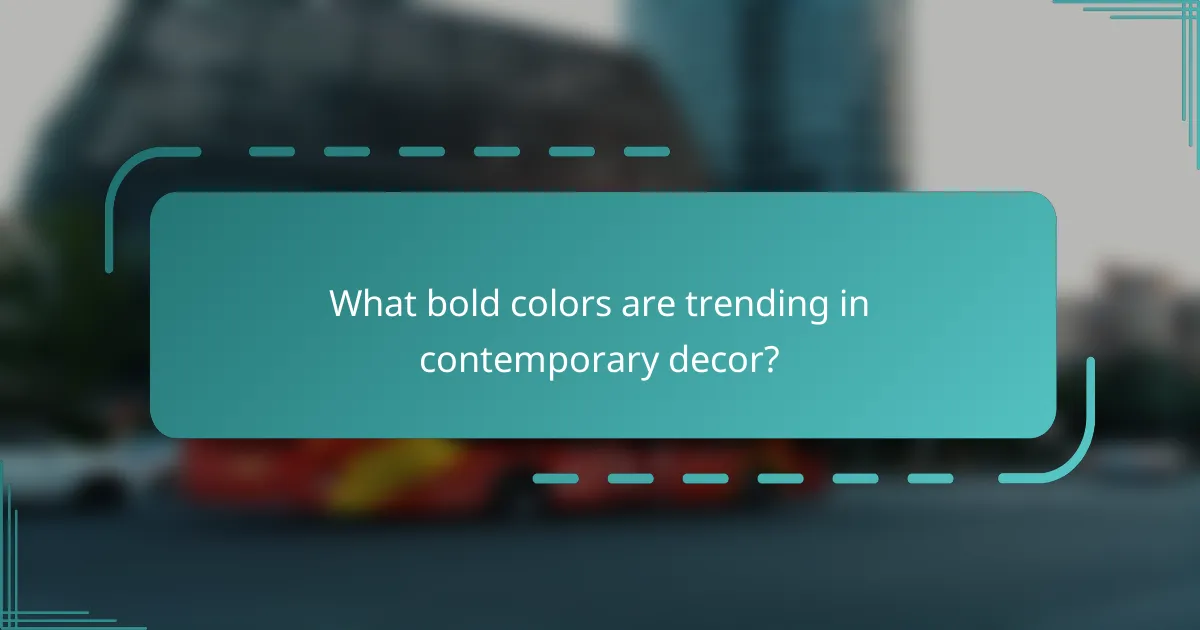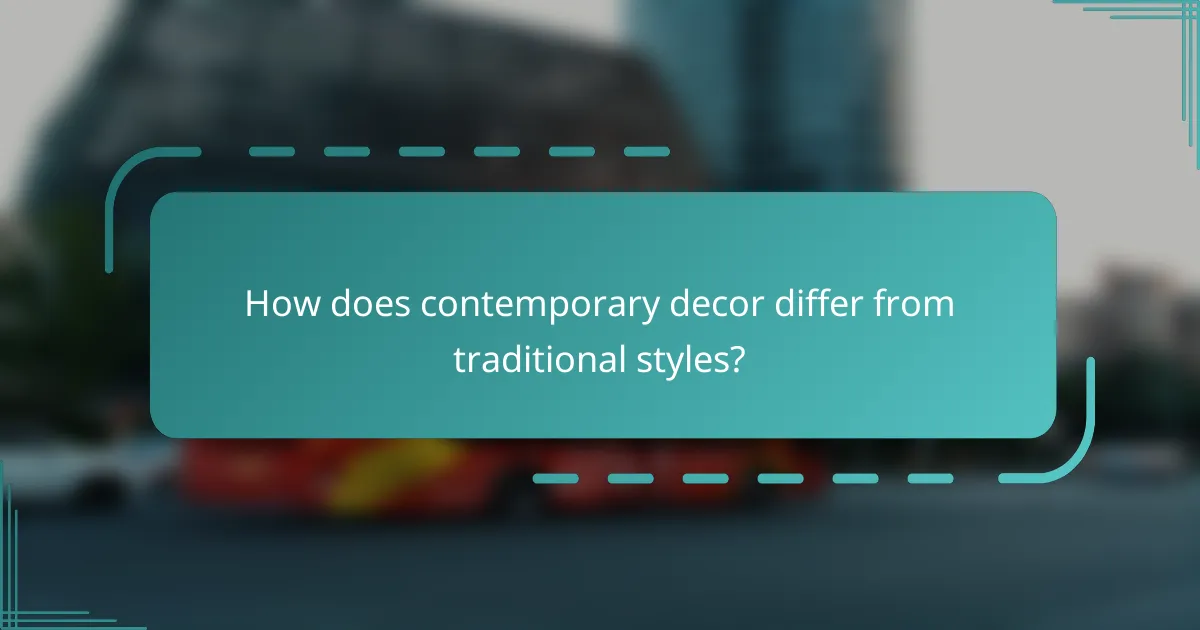Contemporary decor is defined by its emphasis on sleek lines and bold colors, merging minimalism with vibrant aesthetics. This approach creates spaces that are not only functional but also visually captivating, inviting a sense of modern sophistication. By focusing on clean designs and striking color palettes, contemporary interiors can evoke emotion and transform everyday environments into dynamic experiences.

What are the current trends in contemporary decor?
Current trends in contemporary decor emphasize sleek lines, bold colors, and a blend of minimalism and maximalism. These styles reflect a desire for both simplicity and vibrancy, creating spaces that are functional yet visually striking.
Minimalist design
Minimalist design focuses on simplicity and functionality, often featuring clean lines and a limited color palette. This approach encourages decluttering and the use of essential furniture pieces, allowing for open spaces that feel airy and calm.
When adopting minimalist decor, consider using neutral tones like whites, grays, and beiges, complemented by a few statement pieces. Aim for a balance between aesthetics and practicality, ensuring that each item serves a purpose.
Maximalist aesthetics
Maximalist aesthetics celebrate bold colors, patterns, and textures, creating a rich and layered environment. This trend allows for personal expression through eclectic combinations of furniture, art, and decor elements.
To incorporate maximalism, mix various styles and colors, but maintain some cohesion through a common theme or color palette. Be mindful of balance; too many competing elements can create visual chaos rather than harmony.
Biophilic elements
Biophilic design integrates natural elements into interiors, promoting a connection with nature. This trend often includes the use of plants, natural materials, and ample natural light, enhancing well-being and tranquility.
Incorporating biophilic elements can be as simple as adding indoor plants, using wood or stone finishes, and maximizing window space. Aim for a harmonious blend of indoor and outdoor spaces to foster a calming atmosphere.
Smart home integration
Smart home integration involves incorporating technology into decor for enhanced convenience and efficiency. This trend includes smart lighting, thermostats, and security systems that can be controlled remotely.
When integrating smart technology, choose devices that blend seamlessly with your decor. Consider user-friendly options that enhance your lifestyle without overwhelming your space with gadgets.
Vintage and retro influences
Vintage and retro influences bring character and nostalgia into contemporary decor. This trend often features furniture and decor items from past decades, creating a unique and personalized aesthetic.
To effectively incorporate vintage elements, mix them with modern pieces for contrast. Look for authentic items at thrift stores or online marketplaces, and consider reupholstering or refinishing to fit your desired style.

How to incorporate sleek lines in decor?
Incorporating sleek lines in decor emphasizes simplicity and modernity, creating a clean and sophisticated aesthetic. Focus on furniture and design elements that feature straight edges and minimal ornamentation to achieve this look.
Use of geometric furniture
Geometric furniture plays a crucial role in achieving sleek lines in decor. Look for pieces with sharp angles and clean shapes, such as rectangular coffee tables or angular chairs. These designs not only enhance the visual appeal but also create a sense of order in the space.
When selecting geometric furniture, consider materials like metal or glass, which can further accentuate the modern feel. Avoid overly ornate styles that can clutter the look and detract from the sleek design.
Open floor plans
Open floor plans are essential for promoting sleek lines in contemporary decor. By removing unnecessary walls, you create a seamless flow between spaces, allowing for uninterrupted sightlines. This openness enhances the feeling of spaciousness and highlights the clean lines of your furniture and decor.
To maximize the benefits of an open floor plan, use consistent color palettes and materials throughout the space. This cohesion helps maintain a streamlined look and reinforces the modern aesthetic.
Streamlined cabinetry
Streamlined cabinetry is another effective way to incorporate sleek lines into your decor. Opt for cabinets with flat fronts and minimal hardware to create a smooth, uninterrupted surface. This design choice not only looks modern but also makes spaces feel larger and more organized.
Consider using high-gloss finishes or natural wood tones to enhance the sleek appearance. Avoid bulky or decorative cabinet styles that can disrupt the clean lines you aim to achieve.
Architectural features
Architectural features can significantly contribute to a sleek decor style. Incorporate elements like large windows, straight staircases, and simple molding to emphasize clean lines throughout your space. These features not only enhance the aesthetic but also allow natural light to flow, further highlighting the modern design.
When planning architectural features, focus on symmetry and proportion to maintain a balanced look. Avoid overly intricate designs that can detract from the sleekness of the overall decor.

What bold colors are trending in contemporary decor?
Bold colors in contemporary decor are characterized by their ability to create striking visual impact and evoke emotions. Current trends highlight vibrant jewel tones, earthy shades, pastel accents, and contrasting color palettes that can transform spaces into dynamic environments.
Vibrant jewel tones
Vibrant jewel tones such as emerald green, sapphire blue, and ruby red are gaining popularity for their richness and depth. These colors can be used as statement pieces in furniture or accent walls, adding a luxurious feel to any room.
When incorporating jewel tones, consider pairing them with neutral shades to balance the intensity. For example, a deep blue sofa can be complemented with light gray or beige accessories, creating a sophisticated look without overwhelming the space.
Earthy shades
Earthy shades like terracotta, olive green, and warm browns are trending for their calming and grounding effects. These colors resonate with nature and can create a cozy atmosphere in living areas or bedrooms.
To effectively use earthy tones, think about layering different shades and textures. For instance, combining terracotta pots with olive green plants can enhance the organic feel of a room, making it inviting and serene.
Pastel accents
Pastel accents, including soft pinks, light blues, and mint greens, are being used to add subtle color without overwhelming a space. These gentle hues work well in smaller decor items like cushions, artwork, or decorative vases.
Incorporating pastel accents can brighten up a room, especially when paired with darker furniture or walls. For example, a pastel pink throw pillow on a charcoal gray couch can create a striking yet harmonious contrast.
Contrasting color palettes
Contrasting color palettes, which combine bold and muted tones, are a popular choice for creating visual interest. This approach allows for creativity and personalization in decor, making spaces feel unique and dynamic.
To effectively use contrasting palettes, select one bold color and pair it with a complementary muted tone. For instance, a bright yellow chair can be beautifully offset by a soft gray wall, making the chair pop while maintaining a cohesive look.

What are the key criteria for selecting contemporary decor?
When selecting contemporary decor, focus on functionality, personal style, and material durability. These criteria ensure that your decor not only looks modern but also serves practical purposes and withstands the test of time.
Functionality and usability
Contemporary decor should prioritize functionality and usability, meaning that each piece should serve a purpose while enhancing the overall aesthetic. Consider how furniture and decor items will be used in daily life; for example, choose a coffee table that offers storage or a sofa that converts into a bed.
Evaluate the layout of your space to ensure that the decor complements movement and accessibility. Avoid overcrowding areas with unnecessary items, as this can hinder usability and create a cluttered appearance.
Personal style alignment
Your contemporary decor should reflect your personal style while adhering to modern design principles. Identify the colors, patterns, and textures that resonate with you, and incorporate them into your decor choices to create a cohesive look.
Mixing bold colors with sleek lines can create a striking contrast, but ensure that the overall design remains harmonious. Consider creating a mood board to visualize how different elements will work together before making purchases.
Material durability
Durability is essential when selecting materials for contemporary decor, as high-quality materials will last longer and maintain their appearance. Look for furnishings made from sturdy materials like hardwood, metal, or high-performance fabrics that can withstand wear and tear.
Research the maintenance requirements of different materials to ensure they fit your lifestyle. For instance, leather may require regular conditioning, while certain fabrics may be more prone to staining. Choosing durable materials can save you money in the long run by reducing the need for replacements.

How does contemporary decor differ from traditional styles?
Contemporary decor is characterized by its emphasis on minimalism, clean lines, and bold colors, contrasting sharply with traditional styles that often feature ornate details and rich textures. While traditional decor tends to evoke a sense of nostalgia and warmth, contemporary design focuses on functionality and simplicity.
Focus on simplicity
Simplicity is a cornerstone of contemporary decor, prioritizing uncluttered spaces and streamlined furniture. This approach often involves using fewer decorative elements, allowing for a more open and airy feel in a room.
When selecting furniture and decor, aim for pieces that embody sleek lines and a minimalist aesthetic. For instance, a low-profile sofa with a neutral color can serve as a focal point without overwhelming the space.
To achieve simplicity, consider using a limited color palette, typically featuring bold hues paired with soft neutrals. This combination can create striking contrasts while maintaining a cohesive look throughout the space.
